There truly is a snake for everyone. With a vast array of colorations, patterning, temperaments, sizes, and lifespans snakes are some of the most unique animals on Earth.
They may not have the best reputation thanks to Hollywood, but snakes are actually docile, rewarding pets that are a great fit for families who are looking for something a little different.
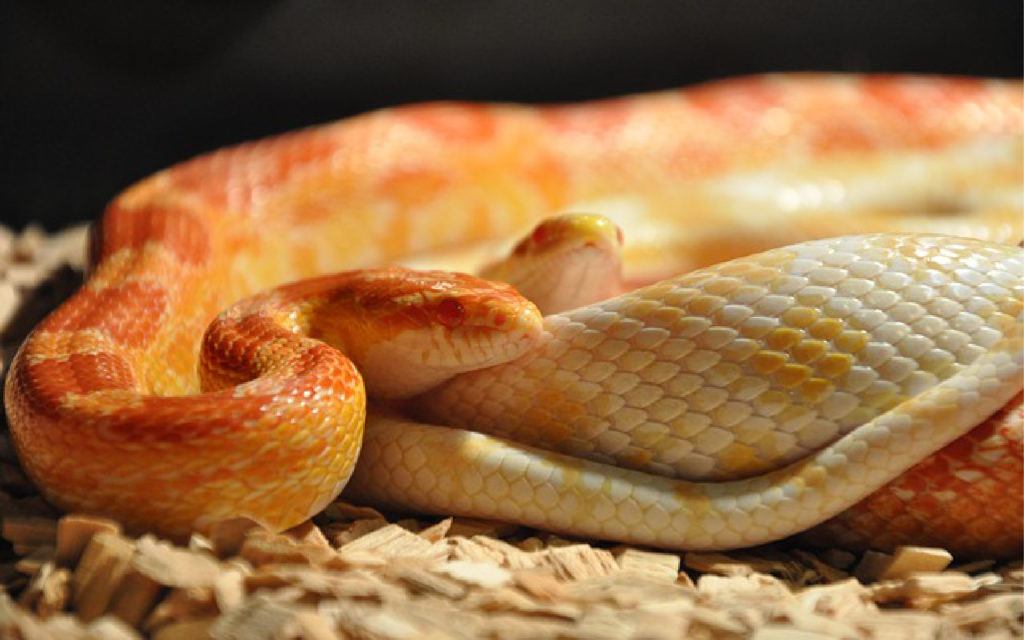
Many snakes are comfortable being handled, and their care requirements are straightforward enough for beginners to manage easily.
In this article we will cover the basics of caring for pet snakes, as well as a list of many of the best types of snakes that can be kept as pets!
Note: the legality of owning some snake species varies by state; check your local laws before adopting any reptile.
Quick Navigation
Popular Types of Pet Snakes: Species Guide
Here are our 16 favorite snake species for reptile lovers interested in a new and interesting pet:
1. Milk and King Snakes
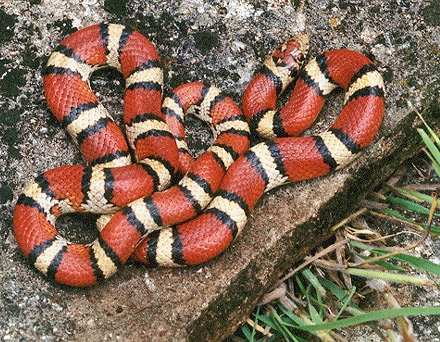
- Scientific name: Lampropeltis triangulum
- Difficulty of care: Beginner
- Length at hatch: 8-12 inches
- Adult length: 6-7 feet depending on variety
- Life expectancy: 10-20+ years
- Diet: Small frozen and thawed rodents
Milk and king snakes are very popular snakes to keep as pets due to their small size and bright, beautiful coloration. They are known for their bright red, black, and yellow/white striping, though some variants are almost solid red with blotches of black or white.
The two popular snake varieties are so similar that they are usually lumped together into “milk and king snakes”.
These snakes require lower humidity and habitat temperatures than many tropical snakes, making them an ideal “beginner” snake for anyone who does not have extensive experience maintaining a reptile habitat.
They stay relatively small and are easy to care for.
Milk and king snakes may take some time to settle down initially after introducing them to your home, and it may take several handling sessions before they start to grow accustomed to being held.
The snakes may wiggle and try to get free at first but will become more docile with time.
It should be noted that these snakes have been known to prey on other snakes, so they should be housed individually.
2. Corn Snakes
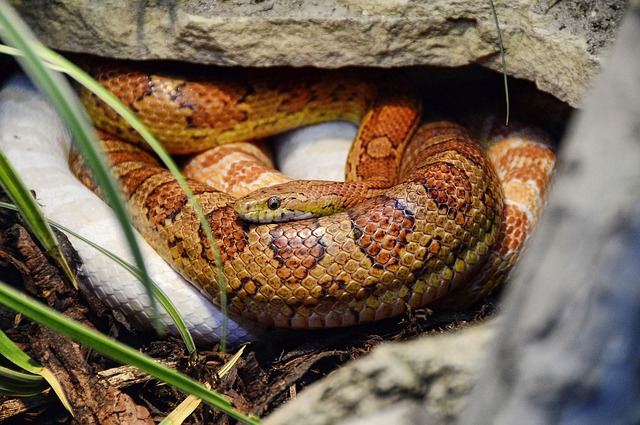
- Scientific name: Pantherophis guttatus
- Difficulty of care: Beginner
- Length at hatch: 12-14 inches
- Adult length: 4-6 feet
- Life expectancy: 15-20+ years
- Diet: Frozen and thawed rodents; small birds
Sometimes referred to as red rat snakes, Corn snakes are native to the southeastern U.S., and are an excellent choice as a pet. They are docile and stay relatively small, making them a great beginner snake.
Their stunning red and orange coloring is highly variable as a result of breeding. Corn snakes are also generally very relaxed and are amenable to being handled.
Due to their natural home range they are big fans of burrowing and hiding and require a habitat that is set up for that type of behavior.
They also like to test the limits of their enclosure and will push at the tank lid with their nose, meaning they need a very secure habitat so they don’t escape!
3. Western Hognose Snakes

- Difficulty of care: Intermediate, due to behavior
- Length at hatch:
- Adult length:
- Life expectancy: 8-10 years
- Diet: Frozen and thawed rodents
The Western Hognose snake is best known for the distinctive facial feature that is also its’ namesake: the upturned nose that gives the impression of a hog!
Western hognose also stay small as pet snakes go, which can be an appealing feature for some snake owners.
Their brown/beige/white coloration helps them to blend in with their natural habitat in the wild, but these snakes can now be found in a multitude of colors and patterns due to selective breeding.
Western Hognose snakes are perhaps better snakes for handlers with some snake experience, as they have been known to hiss and strike unexpectedly, which may not be ideal for novices or young children.
However, if the snakes are introduced to the home when they are young and they are handled often and properly, they are a good choice for pets.
4. Ball Pythons
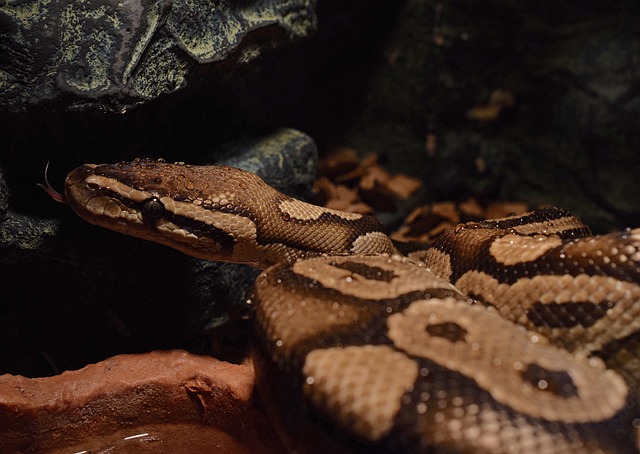
- Difficulty of care: Beginner
- Length at hatch: 10 inches
- Adult length: 3-5 feet
- Life expectancy: 20-30+ years
- Diet: Appropriately sized mice and rats
Ball pythons, while they may seem intimidating, are actually incredibly docile and make excellent pets for families, children, and first time snake owners.
Ball pythons get their name from the ball-shape that they curl into when they feel threatened. they are shy but friendly, and actually thrive in captivity.
Their regal black and brown patterning has gained them quite the following in the herpetocultural world, but they are now available in a multitude of captivating colors and patterns as a result of selective breeding.
Caring for ball pythons is fairly straightforward.
They need a few good hiding spots in their enclosures, as well as hot and cool spots to help them regulate their temperature.
Ball pythons are known for their tendency to stop eating for periods of time, especially the winter, as well as during shedding. This is normal but is one of many reasons that ball pythons must be carefully monitored.
It is crucial to do research and provide proper care for all snakes, and pythons are easy to care for but still require some education.
5. Black Rat Snakes
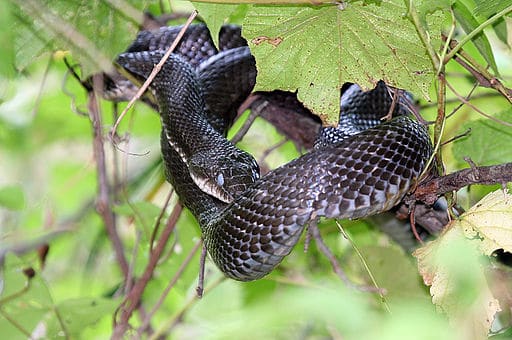
- Difficulty of care: Beginner
- Length at hatch: 13 inches
- Adult length: 3-8 feet
- Life expectancy: 10 to 30 years
- Diet: Frozen then thawed rodents
Black rat snakes are among the most popular pet snakes, and for good reason. They are docile, friendly, and easy to care for.
Black rat snakes are sometimes mistaken for rattlesnakes due to their behaviors, but they are not venomous or aggressive.
They are also on the smaller side of most pet snake varieties, and have less strict temperature requirements, making them ideal for beginners who are just learning how to maintain a snake habitat.
Black rat snakes are swimmers and climbers, and therefore need habitats which are designed to keep them safely inside to accommodate their escapist habits!
6. Green Tree Pythons
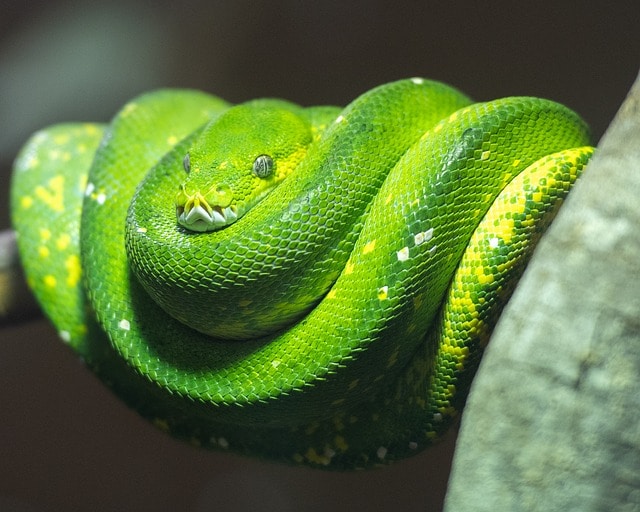
- Difficulty of care: Advanced
- Length at hatch: 8-10 inches
- Adult length: 4-6 feet
- Life expectancy: 10-15 years
- Diet: Appropriately sized rodents
These beautiful pythons have earned their namesake for the amount of time they like to spend coiled up in trees.
The green morph is the most common, but these pythons come in a variety of colors due to natural and selective breeding. However, these snakes are not for beginners due to their attitude and temperaments.
They are best kept as display snakes rather than pets to be handled, as they are known to become defensive, though they can be handled by experienced snake parents.
They are very beautiful to watch as they curl up and balance on branches, and for this reason they need habitats with a great deal of space for perching and horizontal space to spread out.
7. Kenyan Sand Boas
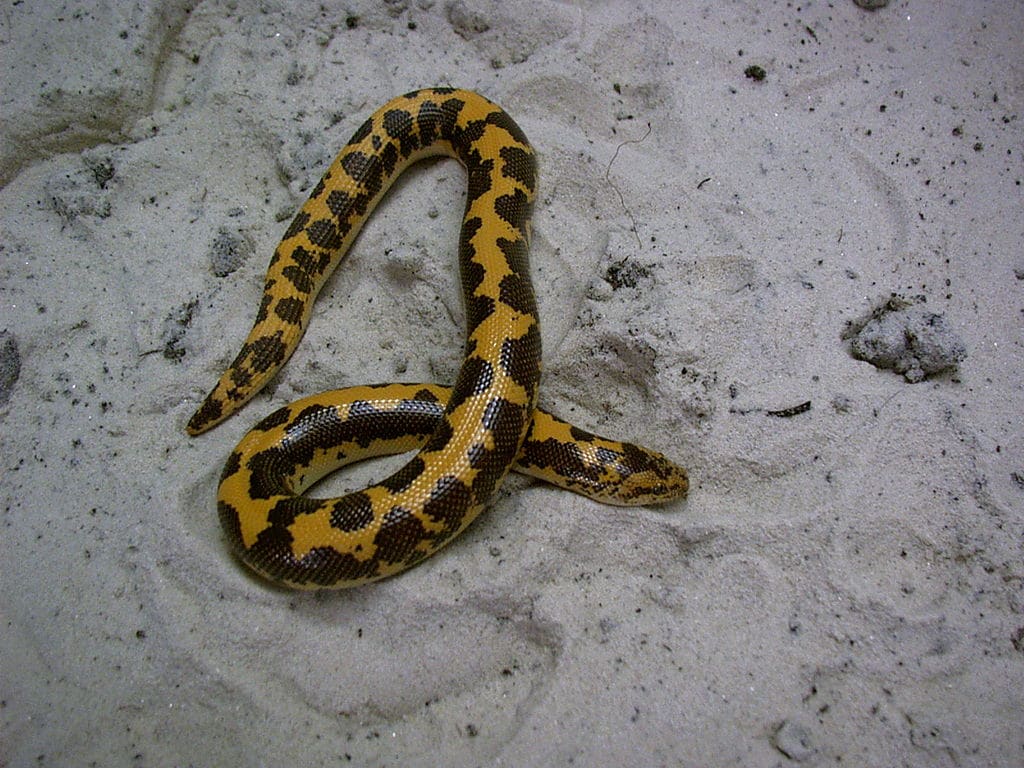
- Difficulty of care: Beginner
- Length at hatch: 5 inches
- Adult Length: 1.5-2 feet (females are larger)
- Life expectancy: 20+ years
- Diet: Frozen then thawed rodents
Kenyan sand boas may not be as popular as other breeds, but they are quickly gaining a following as they make excellent pets!
These boas are much smaller than other varieties of boa, and are very passive which makes them good candidates for handling. They do not require large habitats, though they do need securely fastened lids, or they will nudge the lids off and escape!
Kenyan sand boas are not climbers, and prefer to spend time underground, burrowing and require a habitat which will suit their needs.
With some time and patience, Kenyan Sand Boas can be excellent pets for even the most novice of snake enthusiasts.
8. Garter Snakes
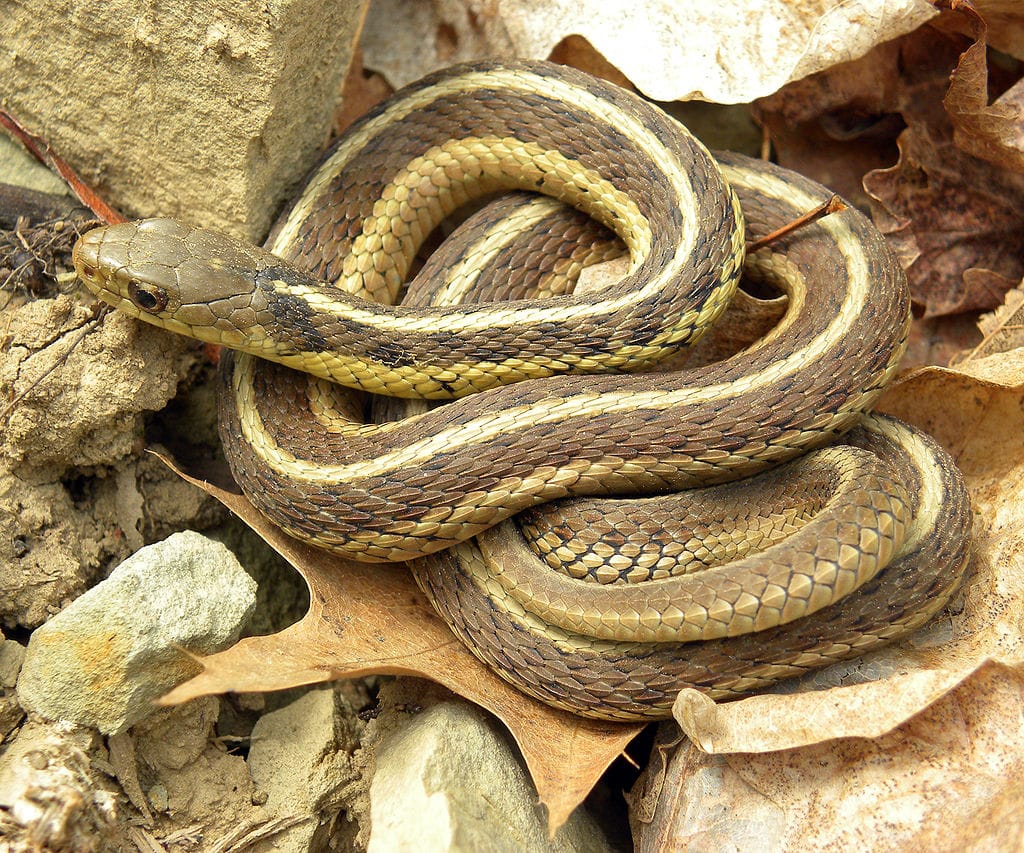
- Difficulty of care: Beginner
- Length at hatch: 6-8 inches
- Adult length: 2-3 feet
- Life expectancy: 5-10 years
- Diet: Pinkie mice, small feeder fish
Looking for a small, friendly snake that’s great for beginners, families, and children? Garter snakes are the pets for you!
These small snakes are active during the day, are very alert, and are just plain adorable. They love water and are fun to watch, and can be handled as long as they are conditioned with regular handling from a young age.
These snakes come in a huge array of colors and patterns, and love to burrow and swim. There are few snakes better suited to families and children than garter snakes!
9. Rosy Boas
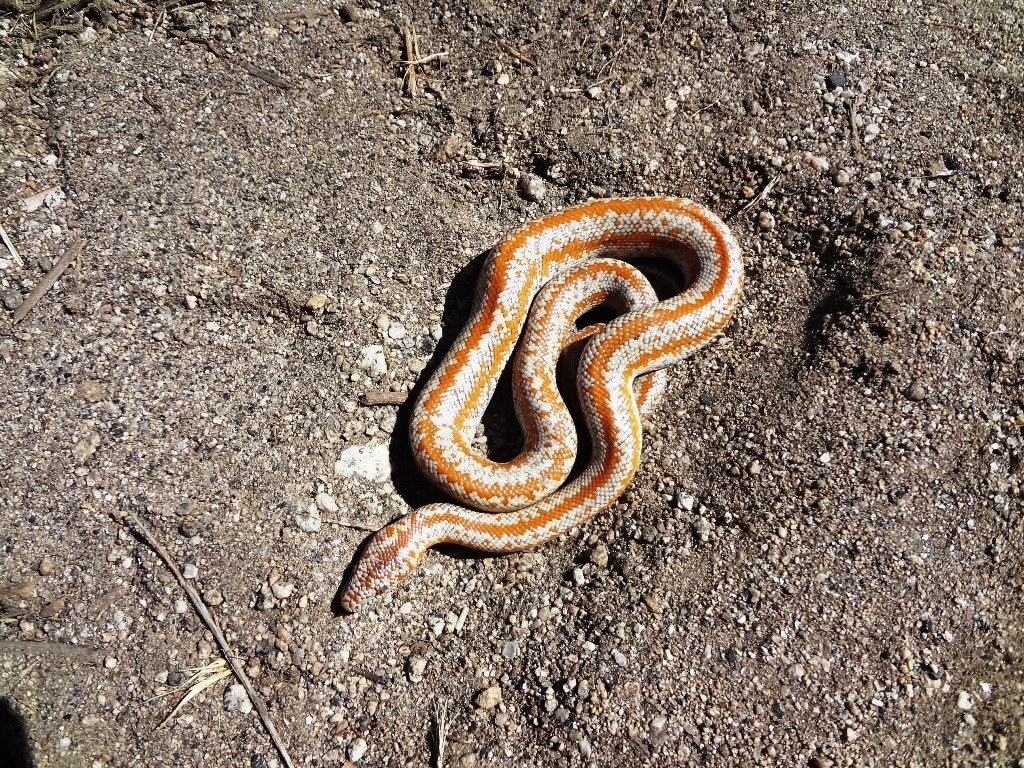
- Difficulty of care: Beginner-Intermediate
- Length at hatch: 10 inches
- Adult length: 4 feet
- Life expectancy: 20+ years
- Diet: Small mice/rats
Rosy boas are excellent snakes for committed beginners. They are known for being long-lived if given the proper medical and habitat care.
The “rosy” name comes from the pearl and coral coloration that is typical of these boas, though many variants are now available.
Of all the snakes mentioned here, the rosy boa is perhaps the most likely escape artist- even the smallest opening could be a potential escape for a rosy boa!
In addition to an escape-proof enclosure, it is recommended to avoid using wire mesh or other screening as these materials could harm your snake as it tests the cage and try to make its escape.
10. False Water Cobras

- Difficulty of care: Advanced
- Length at hatch: 15-18 inches
- Adult length: 4-8 ft.
- Life expectancy: 12-20 years
- Diet: Appropriately sized mice, rats, chicks, fish, frog legs
False water cobras are the most sexually dimorphic of the snakes covered so far.
They differ in length and coloration/patterning between males and females, with both sexes featuring a hood that is displayed when feeling defensive or threatened. These snakes feature stunning, unique brown, black, and tan coloration.
False water cobras are shy snakes, and are recommended only for experienced snake handlers and owners.
They can get very defensive and may strike, and their bites are venomous which may cause injury. However, if you have the patience and experience, these beautiful snakes can be kept as very rewarding pets!
11. Pine Snakes
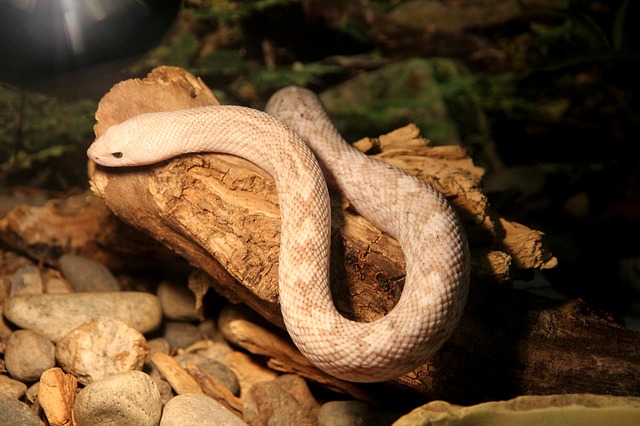
- Difficulty of care: Intermediate-Advanced
- Length at hatch: 18-24 inches
- Adult length: 5-8 ft.
- Life expectancy: 20+ years
- Diet: Appropriately sized rodents or poultry
Pine snakes may not be as common to find in pet stores, but they are very unique snakes that lend themselves well to being in captivity.
They tend to be very large as adults, and require a great deal of space in their habitat to keep them happy and healthy. They are known for their large size and contrasting coloration.
Pine snakes need to be handled often when they are young in order to get them used to humans, or else they can become antisocial and defensive.
Pine snakes can be nervous but are very curious and can be handled with caution. They thrive when they have a large, interesting environment to explore.
These pets require a bit more knowledge and expertise but are well worth the effort.
12. Gopher and Bull Snakes

- Difficulty of care: Beginner
- Length at hatch: 12 in.
- Adult length: 4-6 ft.
- Life expectancy: 15+ years
- Diet: Frozen and thawed rats
Gopher and bull snakes are two different subsets of the same snake species, with bull snakes being the largest of the group.
These constrictors are non-venomous and make great pets due to their minimal requirements which are easy for beginners to provide.
These snakes feature striking tan and brown patterning which helps them blend into their natural environment, and are famous for their bold and curious temperaments.
They are very keen on exploring their environments, and definitely need enclosures designed to prevent them from escaping!
Gopher and bull snakes can be handled and held but they can be active and might squirm, even after they get used to being handled.
They might hiss and rattle their tails if they are not interested in being handled- you will never have to wonder what these snakes are thinking, because they will certainly let you know!
13. Red-Tail Boa
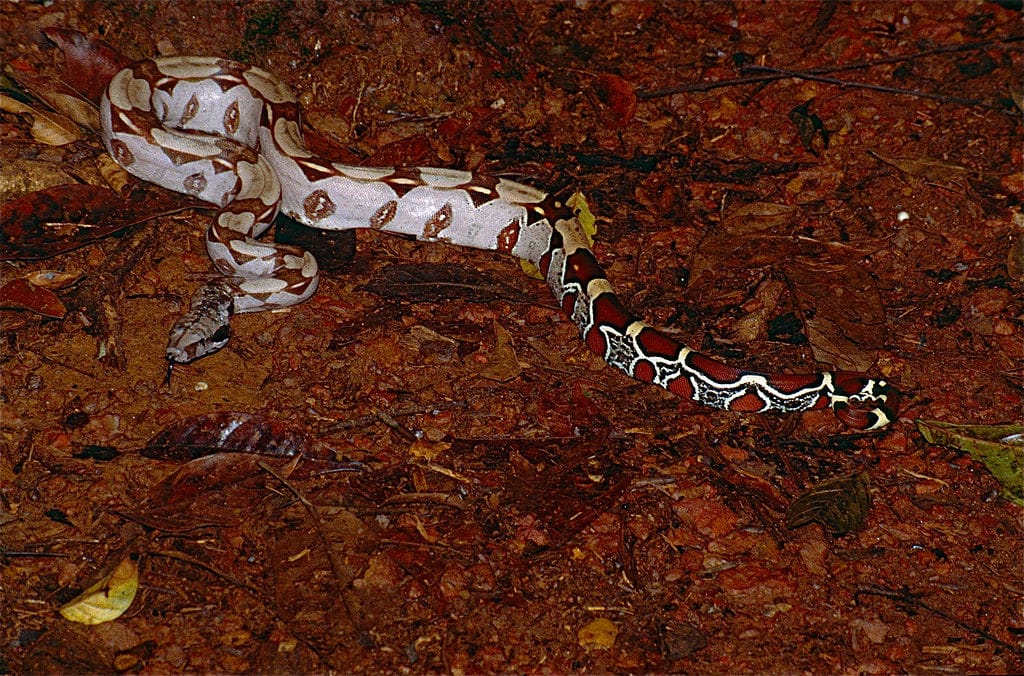
- Difficulty of care: Advanced-Expert
- Length at hatch: 14-22 inches
- Adult length: 8-10 ft.
- Life expectancy: 30+ years
- Diet: Frozen and thawed rats and rabbits
Red-tail boas are one of the more famous boa constrictors, named for the bright red coloration on the end of their tails.
These boas are definitely not recommended for beginners, for a few reasons. Though beautiful, these snakes grow to a formidable size as far as pets go, and they can weigh up to 50 pounds when fully grown.
They are not aggressive normally, and are actually known for being docile, but they are still constrictors and they can cause serious injury if they decide to unexpectedly constrict or bite their owners.
Another consideration with red-tail boas is their habitat and diet needs.
They require at least 8-10 feet of habitat space to be able to uncoil and explore without being too cramped.
The natural tropical environment of the boas needs to be replicated as closely as possible, which means maintaining a standard temperature and humidity in a large enclosure (not exactly a task for a novice).
Their diet is also a bit more of an undertaking, as adult red-tail boas require full size rats and rabbits to feast on.
These snakes are lovely, challenging creatures to keep, but they certainly require more experience and care than some other species.
14. Asian Vine Snakes

- Difficulty of care: Advanced-Expert
- Length at hatch: 12-16 inches
- Adult length: 5-6 feet
- Life expectancy: 10-15 years
- Diet: Small lizards (anoles, etc.), small birds, fuzzy mice
Asian vine snakes, also known as whip snakes, have a unique, streamlined appearance that is designed to help them blend in with tropical vines.
They have thin, bright green/teal bodies which are perfectly adapted for a life among the tree branches- which is what their enclosures must replicate.
They are arboreal snakes and need vertical enclosures with plenty of branches and places for climbing as well as hide boxes at multiple levels in the enclosure.
Asian vine snakes are not recommended for beginners as they are docile, but venomous and require cautious handling with gloves and tongs.
They are unique and attractive snakes but require a bit more experience on the part of the owner to keep the snakes healthy and the owner safe.
15. Water Snakes
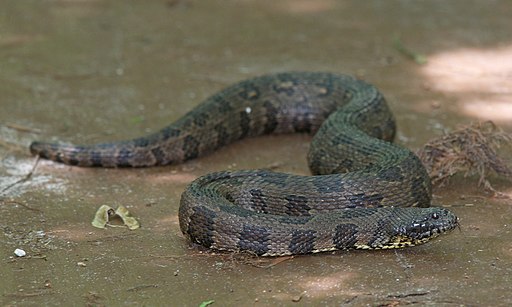
- Difficulty of care: Intermediate
- Length at hatch: Approx. 8-12 inches
- Adult length: 3-5 feet
- Life expectancy: 10+ years
- Diet: Goldfish, crickets, earthworms, frozen and thawed rodents
Water snakes vary greatly in coloration and patterning based on subspecies, but they can range from black and red to orange, brown, and even greyish-silver.
While they are generally docile snakes, they require a slightly higher level of care, more specific habitat features, and a more complex diet than many other snakes.
Water snakes actually require a dry environment (though drinking water should always be available), in order to prevent infections in their scales.
This means more frequent cleaning and use of specific bedding to prevent infection and unwarranted moisture in the enclosure.
Additionally, their diet should consist of a combination of fish, insects, and occasionally small rodents to replicate the variety of prey found in their natural environments.
Water snakes can be handled but must be handled from a young age or they may become nervous and strike; however if they are accustomed to normal handling they are very calm snakes to keep.
Excellent for slightly more advanced snake owners looking for a species who needs just a bit more attention. The extra time and care is well worth it!
16. Reticulated Pythons

- Difficulty of care: Advanced-Expert
- Length at hatch: 24 inches
- Adult length: 10-20 feet
- Life expectancy: 15-20+ years
- Diet: Live appropriately sized rodents or frozen and thawed rodents depending upon individual python
Many snake owners have been put off of reticulated pythons due to their history as being aggressive and difficult to handle and care for.
While this may be true of reticulated pythons in the wild, breeding in captivity has allowed the true nature of these pythons to shine.
Reticulated pythons are extremely intelligent reptiles with general good temperaments and relatively straightforward care, which makes them excellent pets for more advanced owners.
These pythons have highly patterned, iridescent scales and muscular bodies which is fascinating to observe and makes them pleasant to handle as well.
Reticulated pythons, due to their size, require larger enclosures than many other pet snakes, and due to their long lifespans are certainly a commitment.
They may only eat live prey depending upon the individual python, which can sometimes be a challenge for less experienced snake owners as well.
As far as handling, reticulated pythons may expect food whenever their cage is opened and must be “trained” to know that it is not being fed prior to handling.
This may take some time, and it is recommended to have another handler present whenever the python is being handled to avoid accidental striking due to nervousness.
Caring for Pet Snakes
Generally speaking, snakes require the same basic care as all reptiles: water, food, a heating source, appropriate enclosure and substrate, and (depending on species) a UV light.
A local pet store can provide details about which enclosures, substrates, and heating are best for specific snakes.
Most snakes require a substrate which will not irritate their scales, and a heating setup that will not cause burns but will help regulate the humidity in the enclosure.
Snakes’ diet also varies based on species, but most snakes eat frozen rodents that have been thawed out fully prior to feeding.
They should not be thawed in the microwave, but should also not be provided while still cold. Unlike many other animals, snakes only need to eat every several days-weeks (depending upon species).
When feeding, it is important to move the snake out of its normal enclosure and into a feeding enclosure so that it knows not to expect food in its “home”. This helps to prevent aggressive behavior and striking when removing the snake to be handled.
When handling a snake, it is crucial to wash hands thoroughly and not handle the snake within 2 days of feeding or shedding. This can cause digestion and health issues.